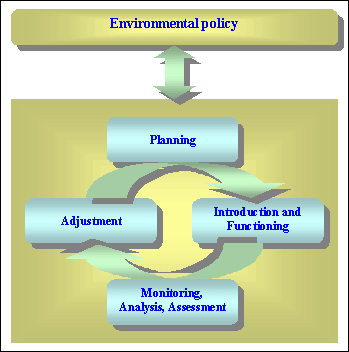| 1. The enterprise must have an environmental policy elaborated | It draws up a special document of intents and principles of organization that must serve as a base for the enterprise's activity and determination of its environmental tasks and objectives. The environmental policy must match the extent, the character and the environmental influence of the entity's life.
The environmental policy, among other things, must declare the management's will to observe all norms and standards, to work on "continual improvement" of the environmental management system (EMS) and to insure "pollution prevention". The document must be made known to all workers of the entity and publicly open
|
|---|
| 2. The enterprise must work out and keep to the techniques of assessment of its influence on the nature | Here are to be considered and taken into account influences exercised not only by the enterprise's direct activity but also by its products and services.
The entity must systematically regard all requirements of the effective legislation (laws, norms, standards, codices) related to environmental aspects of its activity, its produce and services
|
|---|
| 3. The enterprise must set for itself environmental tasks and objectives | These tasks and objectives are to be formed with due regard for substantial environmental influences and demands of the legislations, and are to:
- contain quantitative date, if possible;
- ensue from the environmental policy;
- reflect each function (sphere of activity) and each level of the organization.
While formulating these tasks and objectives the opinions of "interested parties" are to be taken into account, as well. These are any groups of citizens and individuals, whose interests may be directly affected by environmental conduct of the enterprise
|
|---|
| 4. The enterprise must elaborate a programme of environmental management | This programme is to specify a responsibility system, means and terms of meeting aims and fulfilling tasks |
|---|
| 5. The enterprise must set up an effective system of responsibility | This system is to be backed up by appropriate amount of human, technological and financial resources.
There must be a person responsible for function of the EMS at the top level, who will report periodically to the management the rights of the case. This person may be, for example, the chief environmental management expert
|
|---|
| 6. The personnel must undergo training, including that for action in not ordinary situations |
|---|
| 7. Monitoring of the entity's activities must be carried out | Monitoring (measurement of major parameters) is to be effected in an activity that is likely to affect significantly the environment. Procedures are to be established for checksup on a regular basis as to conformity to the currently effective laws and other requirements |
|---|
| 8. A regular auditing of the environmental management system must be exercised | Audit of the EMS is carried out to ascertain if the entity observes the criteria set, fulfils the requirements of the ISO 14001 standard, has introduced the system and runs it in due way. Audit may be an internal one or be performed by an external organization. The results are to be reported to the enterprise's management |
|---|
| 9. The entity's leaders must periodically examine functioning of the EMS | Consideration and evaluation of the EMS is to be performed by its efficiency and adequacy. A point of necessary amendments to the ecological policy, its objectives and other elements of the EMS needs must be on the agenda. The audit results, the changes in the circumstances and the impetus for "continual improvement" are to be taken into consideration, as well |
|---|


